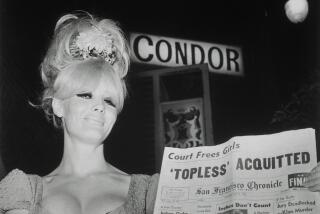Styles Uncover Not-so-Hidden Moral Agenda
- Share via
Those full-body suits competitive swimmers are wearing nowadays to increase their speeds aren’t all that revolutionary.
The six guys in the top photo, posing on rocks off Laguna Beach sometime around 1920, are wearing full-body suits--but for a different reason. They wanted to stay out of jail.
Francis “Doc” Blacketer, 83, artist in residence for the Laguna Beach Historical Society, remembers the suits well.
“You couldn’t go down to the beach without a top on--even the men. They didn’t want to see a man’s bellybutton or his nipples. The lifeguard would give you a citation if you didn’t have a top. If you still wouldn’t cover up, they’d take you to jail.”
Men’s trunks had to extend at least 6 inches below the crotch. The top had to extend down far enough to form a concealing “skirt.”
The suits, almost always gray, were made of cotton thicker than the fabric of today’s T-shirts but thinner than that of jeans. They were soft and tight, and when wet they clung like a second skin.
“That’s when you could parade in front of the girls and show off your muscles. And that’s why we’d throw the girls in the water. Then you could see more--or you thought you could. In those days, it’s what you couldn’t see that turned you on.”
Above, samples of modern Laguna Beach swimwear, modest by current standards. “My God,” said Blacketer, “they would have hanged them.”
*
OC Then and Now calls, (714) 966-5973; e-mail, OCthenand now@latimes.com
More to Read
Sign up for Essential California
The most important California stories and recommendations in your inbox every morning.
You may occasionally receive promotional content from the Los Angeles Times.













